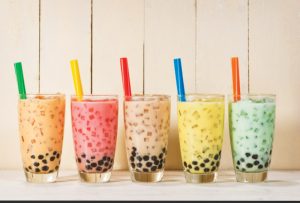Bubble-icious boba
By Hollen Wheeler; courtesy photo


Move over big box coffee shops, a new trend in caffeinated drinks, especially for Generation Z, has swept the nation – boba tea, or more colloquially, just “boba.”
Beginning in Taiwan and migrating around the world, boba or “bubble” as it translates from Chinese, is typically a flavored brewed tea, served cold, with added shaved ice, milk, creamer, sugar and bubbles of chewy tapioca balls which cluster at the bottom of the cup. The tapioca balls, sometimes referred to as “pearls,” are slurped and sucked through a specialty straw, wider than a usual straw. Bobas are often served with cellophane across the brim of the cup. In addition to the bubbles, part of the novelty is punching the straw through the plastic.
Boba is tapioca starch extracted from the roots of the cassava plant, a South American product. Boba begin as white, tasteless and hard, but after hours of boiling and then steeping in sugary syrup, they are transformed into black, chewy treats.
The history of boba began in 1895 when Taiwan became a Japanese colony. Cassava was exported from Brazil and introduced to the Taiwanese. In the 1940s, a mixologist opened a tea shop selling specialty teas, to include what is considered the impetus of the boba drink. By 1980, with economic growth and leisure food on the rise, boba had become a staple in Taiwan.
Today, boba is a billion-dollar industry with a myriad of menu choices – coconut milk tea, mango slush, strawberry green tea, and low sugar options, to name a few. Its presence on social media sites in the last decade (and leisure drinks increasing around the world) propelled its popularity in the U.S. In fact, the boba tea icon became an official emoji in 2020.
There are many national chains, but the best boba, according to some local teens, are found at the mom and pop shops. The kids added that it’s something “different” and “it’s cool to get a drink and snack in one cup.” The cost of one boba runs $5, on average.
Looking to get a boba? Most pho and poke restaurants carry it, including Pho 5 in the City of Castle Pines. Try also Kung Fu Tea, Sharetea – Highlands Ranch, and Mini Moo’s Tea Shop … just a few of the local boba shops to get your bubbles on.
